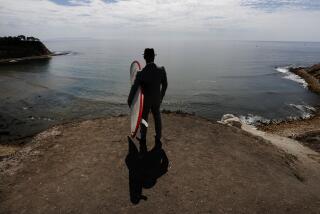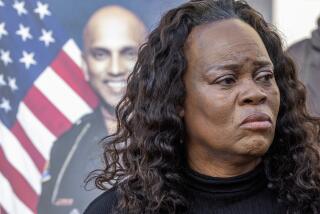Crackdown on ‘Cruising’ : Boyle Heights Task Force Hits Streets--Hard
- Share via
David Garcia is most comfortable speaking Spanish, but there was a point he wanted to drive home about life in Boyle Heights, so he shifted into tentative but outraged English.
“My daughter wakes up in the middle of the night,” said Garcia, who lives in the 1,200-unit Wyvernwood apartment complex, sprawled over 60 acres off East Olympic Boulevard. “And she says, ‘Hey, Poppy, Poppy, somebody fighting.’ I look out the window and there are people making love in the grass!”
According to Boyle Heights residents and police, that kind of after-midnight scene--along with gridlocked streets, drunken fights and shrieking car stereos--has become increasingly common in the creaky Eastside residential neighborhoods near the intersections where Olympic and Whittier boulevards cross Soto Street.
In response to petitions signed by hundreds of residents, Los Angeles police have in the last five weeks mobilized a task force of nearly two-dozen motorcycle officers to cite or arrest hundreds of young men and women who come to Boyle Heights on weekend evenings to “cruise” the main streets.
The trouble isn’t the cruising itself, police say. It’s what happens when the cars stop. The youths--most of whom have driven to Boyle Heights from other communities, many drawn by a popular nightclub--hang out, drink and fight after congregating in or near residential areas.
Residents of Boyle Heights, a poor, cramped Latino community of more than 80,000 encircled by the Golden State, San Bernardino and Pomona freeways, say the influx has steadily mounted during the last two years.
Complaints range from assaults to less dramatic problems, such as the local priest who found a teen-ager urinating in his rectory’s garage or a market owner who was forced to close earlier on weekends because cruisers clog his parking lot.
“It’s petty, but it’s extremely serious,” said Hollenbeck Division’s Sgt. John Haus, the man in charge of the task force, which borrows most of its members from other Police Department divisions.
On the first eight nights that the task force was deployed in January, officers wrote more than 1,000 citations for violations of laws involving drunk driving, open containers of alcoholic beverages, improper vehicle equipment and parking, Haus said.
The crackdown is being funded with part of the $3.7 million that the City Council recently gave the Police Department to beef up such task forces. The money, which pays officers at overtime rates, will run out in about two months, but Hollenbeck officials say they will find a way to continue their operation indefinitely.
The task force has clearly made a dent, as evidenced by far quieter streets on recent weekends, “but the minute we stop, they’ll start right back,” Sgt. Jerry Burns said.
Cruising on streets such as Olympic, Whittier and Soto has been an Eastside tradition for generations. However, police say that in the last few years it has begun to disrupt the relative peace of the Hollenbeck Division, which has long prided itself on having one of the lowest rates for major crimes in Los Angeles.
“They’re gathering in different parks, side streets, they drink, smoke dope, urinate on lawns, turn up their sound systems--you can hear these things 400 feet away,” Haus said.
Police say one reason Boyle Heights has come under siege is crackdowns on cruising in other areas. Numerous jurisdictions have in recent years blocked off popular cruising strips such as Whittier Boulevard in unincorporated East Los Angeles, Montebello and Pico Rivera; Van Nuys Boulevard in the San Fernando Valley and Hollywood Boulevard in Hollywood.
“People found it was easier over here,” as well as Elysian Park in the neighboring Northeast Division, Haus said.
Boyle Heights also affords an unusual number of cul-de-sacs and dead-ends, thanks to the five freeways that knife through the community.
But the reason most often cited for the problems is a withered blue 5-year-old nightclub called Don Quixote East on East Olympic, a popular spot for young Latinos. Police say the influx of trouble began when the club changed its musical focus to a teen-age dance format from Latin dance music geared to adults.
Patrons “come from everywhere,” Haus said. “As far as Santa Barbara, but mostly Huntington Park, South Gate, Monterey Park, Alhambra. Maybe 10% are local. All the rest have heard this is the place to go to.”
Haus estimated that the nightclub, which is restricted to about 700 patrons but is accused by police of having often violated that limit, is responsible for at least half of Boyle Heights’ cruising problems.
Residents tend to blame the club entirely.
“They should just close it down. This (area) used to be so peaceful,” said Alejandro de la Torre, who lives in the Wyvernwood apartments. “It’s not the best of neighborhoods, but it was so nice and quiet.”
Another Wyvernwood resident, Sylvia Escamille, said her husband confronted two-dozen cruisers in late 1985 in an attempt to break up a fight.
“The boys told him it was none of his business,” she said. “They threw a bottle and cut his eye. I called the police, and when they came everybody ran.”
Last week, Los Angeles Superior Court Judge Jerry K. Fields granted a request by the city attorney’s office for a permanent injunction requiring the club’s owners to limit the number of patrons, hire uniformed security guards and obey state liquor laws.
However, the judge refused to approve another condition requested by Deputy City Atty. Pamela Albers, who asked that the club stop selling alcohol at midnight, rather than 2 a.m.
On four occasions in the last year and a half, the state Alcoholic Beverage Commission’s staff has filed accusations against the nightclub for violations, including serving alcohol to minors, serving adulterated alcohol and failing to maintain a restaurant (required if minors are admitted).
In the first three cases, an administrative law judge approved suspending the club’s liquor license for a period ranging from 20 to 45 days. However, the club has appealed those rulings. The most recent accusation has yet to be heard.
Manuel Valenzuela, an attorney who represents the club, has characterized the investigations as harassment. He said the club is already complying with most of the changes sought by the city attorney’s office. And he accused officers of trying to limit the club’s audience by ordering it closed for 30 minutes at a time on Saturday nights, a tactic that he said encourages many patrons to leave. Under police pressure, the club now operates only Friday and Saturday nights, he said.
Much of what the residents are complaining about has been endemic to Boyle Heights for decades, Valenzuela said. “We cannot be responsible for everything that occurs in neighborhoods” near the club, he said.
Connie Velasquez, a field deputy for Councilman Richard Alatorre, whose district includes Boyle Heights, said neighborhood reaction to the crackdown has been overwhelmingly positive.
But one Boyle Heights resident, Richard Resendez, a 26-year-old alarm installation company owner, complained to Alatorre’s office that the task force has employed brutal methods against motorists and Resendez himself.
On the first night that the anti-cruising task force of motorcycle officers was moving through Boyle Heights, Resendez said, he was parking a car in the driveway of his home on Rogers Avenue, a few houses off Soto. One officer demanded he turn down the volume of the car’s radio.
Resendez said he did not feel the volume was excessive, and said that when he declined, the officer cursed him and then knocked him down. A second officer, who arrived a minute later, shoved Resendez’s wife away from the scene and cursed her, Resendez said. Then, he said, the two officers pulled him to the sidewalk and, with his 3-year-old daughter and 8-year-old son watching, kicked him to the ground and handcuffed him.
The officers booked Resendez on suspicion of resisting arrest and interfering with an officer.
The incident is under investigation by the department’s Internal Affairs Division. A Police Department spokesman said that so far “the investigation has not established any (police) misconduct.”
“They turn the streets into what seems to be a ghost town,” Resendez complained. “These kids are getting harassed left and right. They’ve been beating up on people so badly that nobody drives by anymore.”
Velasquez said she believes that police “probably did overreact” in arresting Resendez, but added: “The officers are burned out. They’re tired. Their patience is running out.”
More to Read
Sign up for Essential California
The most important California stories and recommendations in your inbox every morning.
You may occasionally receive promotional content from the Los Angeles Times.










